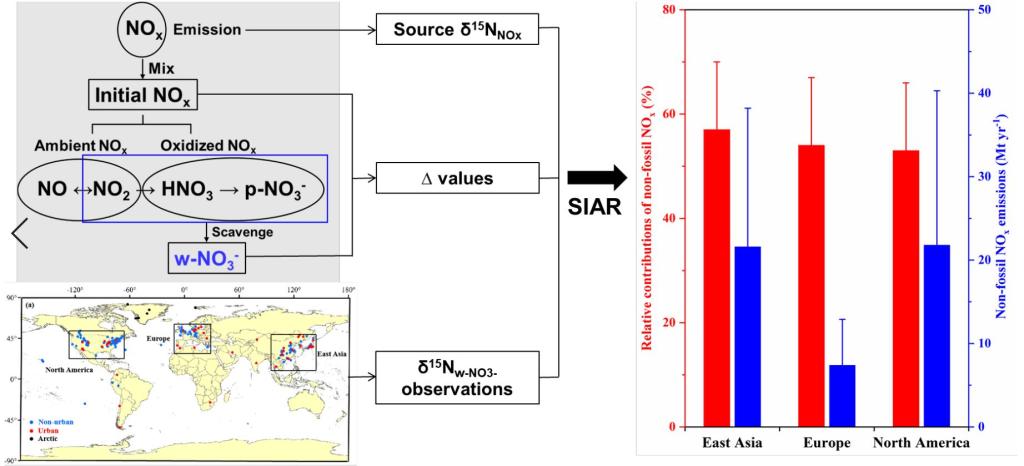Anthropogenic activities have led to the continuous accelerating of reactive nitrogen in the terrestrial atmospheric system since the Industrial Revolution, which has become one of the most prominent global environmental issues. The main cause of increasing atmospheric nitrate (NOy) pollution and deposition flux was assumed to be the emission of nitrogen oxide (NOx) from fossil fuel combustion, primarily via coal combustion and vehicle exhausts. However, due to the difficulty in constraining the emission intensity of non-fossil NOx emissions (such as microbial nitrogen (N) cycles in soils and biomass burning) and its contribution to atmospheric NOx, the relative contributions of fossil-fuel and non-fossil NOx atmospheric NOx, and total NOx emissions are unclear. This can affect the formulation of atmospheric NOx reduction strategies, the budget of N deposition fluxes, and the assessment of ecological effects of N deposition.
In the 1950s, the N stable isotopes of nitrate in precipitation (δ15Nw-NO3-) have been widely employed for tracing atmospheric NOx sources. Especially since 2000, a large number of δ15Nw-NO3- observations have been carried out in East Asia, Europe, and North America (Fig. 1). However, the development of using isotope tracing atmospheric NOx sources was impeded due to the lack of constraining methods on the N isotope effect (Δ) between NOx and w-NO3-. In recent years, Liu et al. from the School of Earth System Science, Tianjin University, developed a method for calculating the process Δ values using N and oxygen isotopes (15N and 17O) and established a quantification scheme to differentiate relative contributions of major NOx sources to atmospheric particulate NO3-, (Liu et al. 2017 Environ. Pollut. 230: 486-494; Song et al. 2019 Environ. Pollut. 248: 183-190; Wang et al. 2019 JGR-Atmospheres. 124: 4174-4185; Song et al. 2020 Sci. Total Environ. 701: 134515; Liu et al. 2020 ES&T Letters 7: 227-233). Recently, they developed an evaluation method for the Δ values of w-NO3- (Fig. 1), then analyzed the temporal-spatial variations of δ15Nw-NO3- values in East Asia, Europe, and North America and their driving forces. They found that the higher coal consumption in East Asia leads to higher δ15Nw-NO3- values than those in Europe and North America. The annual variation trend of δ15Nw-NO3- in recent 20 years mainly reflects the variation of fossil-fuel NOx emissions in major countries in each region. The contribution of non-fossil NOx in the three regions are 57 ± 13% (21.6 ± 16.6 Mt/yr), 54 ± 13% (7.4 ± 5.5 Mt/yr) and 53 ± 13% (21.8 ± 18.5 Mt/yr), respectively (Fig. 1). This study revealed that the emission intensity of non-fossil NOx is underestimated, evaluated non-fossil NOx emissions and updated regional NOx emissions (Fig. 1). These results provided new isotope geochemical evidence for the formulation of atmospheric NOx emission reduction strategies and the assessment of N deposition fluxes and its ecological and environmental effects. Their study published on Nature Communications, entitled “Important contributions of non-fossil fuel nitrogen oxides emissions” on Jan 11, 2021 ( https://www.nature.com/articles/s41467-020-20356-0). Xuejun Liu of China Agricultural University, Greg Michalski of Purdue University, and Wendell Walters of Brown University participated in the study.
This study was supported by the National Natural Science Foundation of China (41730855, 41522301), the State Key Project of Research and Development Plan (2017YFC021001, 2016YFA0600802).

Fig. 1 The source of nitrate in precipitation